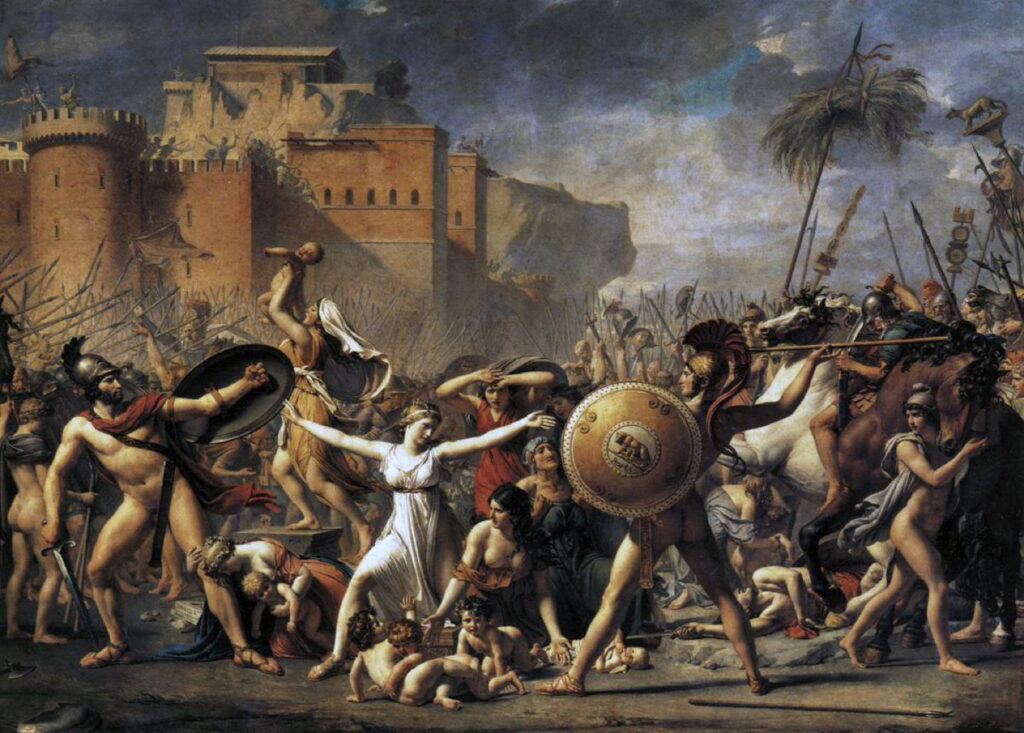Reading visual art: 176 Peace, mythical and ancient

Painting war and conflict is demanding on composition and technique, but how about painting peace? In this week’s two articles examining how to read visual art, I show how some of the masters have risen to that challenge. This article shows examples based on myths and ancient history, and tomorrow’s comes more up to date with more recent events.
One popular approach to depicting the abstract is to use deities from classical mythology who are already associated with war, peace and related concepts.
Jacopo Tintoretto (c 1518-1594), Minerva and Mars (E&I 203) (1578), oil on canvas, 148 x 168, Palazzo Ducale, Venice, Italy. Wikimedia Commons.
Jacopo Tintoretto’s marvellous painting of Minerva and Mars from 1578 is an early example of Minerva (in blue) pushing the god of war (in black armour, at the right) away from her, as her right hand rests on the shoulder of Peace, with Prosperity at the left edge of the canvas.
It was Peter Paul Rubens who excelled in this, as an important international diplomat living at a time of wars throughout Europe, and a master of mythological art.
Peter Paul Rubens (1577–1640), The Triumph of Victory (c 1614), oil on oak panel, 161 x 236 cm, Gemäldegalerie Alte Meister, Kassel, Germany. Wikimedia Commons.
In the young Rubens’ The Triumph of Victory (c 1614), made when he was the finest painter in Flanders, Mars is almost glorified.
The Treaty of Antwerp had been signed in 1609, and the city was flourishing in the Twelve Years’ Truce that ensued. Rubens painted this in about 1614 for the Antwerp Guild of St George, its organisation of archers. Mars dominates, his bloody sword resting on the thigh of Victoria, the personification of victory. She reaches over to place a wreath of oak or laurel on Mars, and holds a staff in her left hand. At the right, Mars is being passed the bundle of crossbow bolts that make up the attribute of Concord. Under the feet of Mars are the bodies of Rebellion, in the foreground, who still holds his torch, and Discord, on whose cheek a snake is crawling. The bound figure resting against the left knee of Mars is Barbarism.
Peter Paul Rubens (1577–1640), Minerva Protects Pax from Mars (Peace and War) (1629-30), oil on canvas, 203.5 × 298 cm, The National Gallery (Presented by the Duke of Sutherland, 1828), London. Image courtesy of and © The National Gallery.
In 1629-30, when Rubens was acting as envoy to King Philip IV of Spain and trying to agree peace between Spain and King Charles I of England, he painted Minerva Protects Pax from Mars (Peace and War), one of his greatest narrative paintings, as a gift with a message for the king of England.
Its central figures are those of Demeter (Ceres), here in the role of Pax (the personification of peace), and Athena, behind her. In attendance are Mars, Hymen, Plutus, and Alecto (one of the Furies), with sundry Bacchantes, a Satyr, putti, and the attributes of Bacchus and Mercury. It’s like an away day from Olympus, or part of an index to Ovid.
If the use of classical deities is too indirect, another approach is to paint historical events of conflicts being resolved in peace.
Early in the history of Rome, its new citizens were overwhelmingly men, and devised a plan to abduct the wives of the nearby Sabine people. That inevitably took the Sabines to war under their king and general Tatius, who led them in their march against Rome. Their task wasn’t easy, as in those days its citadel was on the Capitol hill, a strongpoint for defence. The captain of the guard there had a daughter named Tarpeia. In return for the golden armlets that Sabine warriors wore on the left arm, Tarpeia betrayed the city of Rome by leaving its gates open at night, allowing the Sabines to enter.
As the Sabines swarmed in, Tatius told them to leave what they carried on their left arm with Tarpeia. As they also carried their shields, many misunderstood the command, and Tarpeia was buried under so many shields and golden armlets that she was crushed to death. She was buried where she fell, and that became known as the Tarpeian Rock, the place from which traitors and other enemies of Rome were thrown to their deaths.
With the Sabines in possession of the Capitol, Romulus challenged them to fight. There followed a series of indecisive battles, until Romulus was struck on the head by a rock, and his troops started to retreat to the Palatine hill. He had just regained order and commanded his forces to stand and fight, when the abducted Sabine women invaded the battlefield.
Guercino (1591–1666), Hersilia Separating Romulus and Tatius (1645), oil on canvas, 253 x 267 cm, Musée du Louvre, Paris. Wikimedia Commons.
Guercino’s Hersilia Separating Romulus and Tatius (1645) concentrates on the three figures of Tatius, Hersilia, and Romulus, and tucks the rest of the battle away in the distance behind them.
Jacques-Louis David (1748–1825), The Intervention of the Sabine Women (1799), oil on canvas, 385 x 522 cm, Musée du Louvre, Paris. Wikimedia Commons.
Jacques-Louis David’s The Intervention of the Sabine Women (1799) is unusual among depictions of this episode in showing its resolution, rather than the seizure of the women that brought the conflict about. David shows Roman and Sabine men joined in battle in front of the great walls of Rome, with the Sabine women and their children mixed in, trying to restore peace. Looming over the city is the rugged Tarpeian Rock, where the body of Tarpeia was reputed to have been left buried.
Highlighted in her brilliant white robes in the foreground, and separating two of the warriors, is the daughter of the Sabine king Tatius, Hersilia, whom Romulus married. The warriors are, of course, her father and her husband, and the infants strategically placed by a nurse between the men are the children of Romulus.
David started this painting when he was imprisoned following his involvement in the French Revolution. He intended it to honour his estranged wife, who had continued to visit him during his incarceration, and to make the case for reconciliation as the resolution of conflict.
Moving swiftly on to the rule of Charlemagne in Europe in the late eighth century, we come to his prolonged and bloody series of campaigns against the Saxons in Germany.
Ary Scheffer (1795–1858), Charlemagne Receives the Submission of Widukind (Witikind) at Paderborn in 785 (1835), oil on canvas, 465 × 542 cm, Château de Versailles, Versailles, France. Image by PHGCOM, via Wikimedia Commons.
Charlemagne forced the Engrians to submit to him in 773, pushing on later to Sigiburg. A series of revolts led by Widukind ensured that his forces were kept busy. This turned more savage in 782, when his courts started to hand down death penalties to Saxon pagans who refused to convert to Christianity, and Charlemagne ordered the execution of 4,500 prisoners in the Massacre of Verden. After a further three years of war, the Saxons were finally subdued, and Widukind submitted to baptism. Over a millennium later, Ary Scheffer painted Charlemagne Receives the Submission of Widukind at Paderborn in 785 (1835).
Artist not known, Emperor Friedrich Barbarossa concludes peace in Constance with the Lombards (date not known), media and dimensions not known, Rathaus, Konstanz, Germany. Image by Rainer Halama, via Wikimedia Commons.
In 1175 and 1176, the emperor Barbarossa was defeated at Alessandria and in the Battle of Legnano, where he was wounded and nearly killed. The following year, he was reconciled with Pope Alexander III, and had to humble himself before the Pope in Venice. He also established permanent peace with the Lombards in the second Treaty of Konstanz, in 1183.
The Rathaus in Konstanz has a series of remarkable external murals showing key moments in history, including this undated painting of Emperor Friedrich Barbarossa concludes peace in Constance with the Lombards. Although the name Barbarossa appears in the inscription below, his beard doesn’t appear to be in the slightest bit red, as he shakes hands to seal the peace with the leader of the Lombards.



